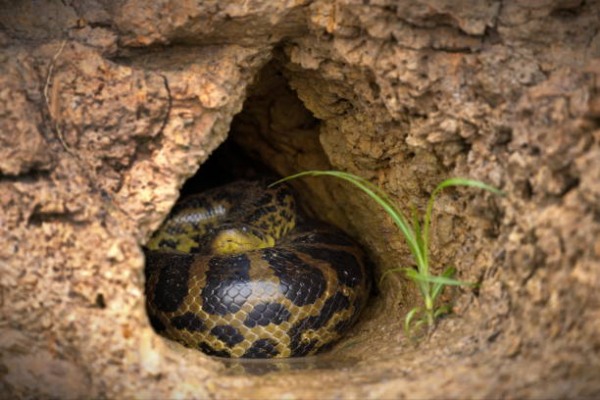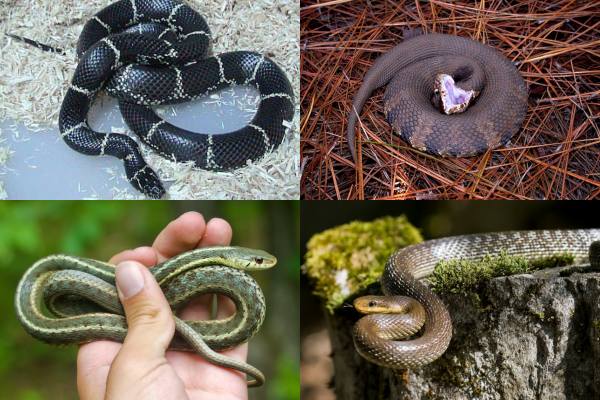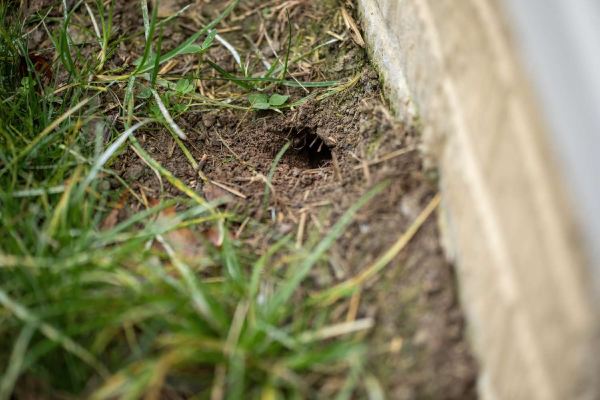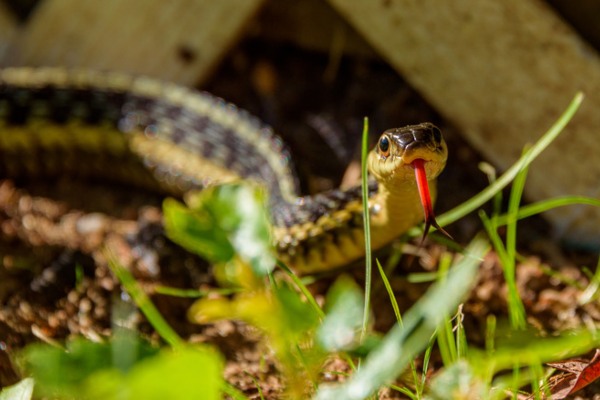It can be unsettling and frightening for anyone to discover snake holes in their yard. There are effective ways to manage and reduce the chances of encountering snakes in your yard. Snakes are often attracted to gardens and yards because they may include small rodents or insects, which are their food sources, as well as shelter options. Hence, any form of holes or burrows should be taken up immediately to avoid them becoming snake habitats. In this article, we are going to discuss practical methods for removing snake holes, why they occur, and some tips you can avoid them from appearing in your garden/yard.
Do snakes dig holes?
No, snakes do not make holes on their own. Instead, they use burrows that other animals have abandoned. Rodents and larger insects often dig these burrows which snakes then use for nesting. Such holes can be found in various places, like grassy areas, dirt or sand piles, or under logs and sticks. Andrew Christopher, owner and operator of Western Mass Wildlife Removal, in Westfield, Massachusetts, remarked,
“Snakes themselves generally don’t ‘dig’ holes. The way to best describe the species of burrowing snakes we have here in the U.S. is that they move very soft, sandy dirt and soils to cover themselves. Snakes are opportunistic and enjoy taking over a burrow that was built by something like a vole, shrew, crawfish, chipmunk, or even tortoise,”
Also, snakes can not create their own burrows or holes due to their physical structure. As a result, the size and shape of snake holes depend on the animal that originally dug them. Some holes may be small and round, while others might be larger and irregular. To determine if a hole is inhabited by a snake, you should look for signs such as shed skins or feces, which usually appear as thick brown liquid with a chalky white end.

Common Types of Snakes
There could be different types of snakes in your yard, and most of them are probably not dangerous. If you could get knowledge of which snakes might pose a threat and which ones are harmless, you would feel more at ease instead of freaking out if you come across them. Here are some of the snakes you might see in your yard include:
Garter Snakes
Garter snakes are harmless and nonvenomous. They are typically between 18 and 30 inches long. You can recognize these snakes by their few yellow stripes running down the length of their bodies. These snakes are found throughout North America in wet, forested areas where they can thrive. Similarly, they are beneficial for the ecosystem as they help control pest populations.
Rat Snakes
Rat snakes are another common and harmless species. They are among the most common snakes found in suburban areas. Typically, they are black, gray, or a combination of black and yellow, and can reach up to 6 feet long. Although rat snakes are nonvenomous, they may bite or strike if they feel threatened. They are often spotted in trees as they can climb. These snakes are found throughout the eastern and midwestern United States and primarily feed on small rodents and birds.
Common Kingsnakes
Kingsnakes have striking black-and-white stripes and can be reached up to 3 to 5 feet long. Like rat snakes, they are nonvenomous but may bite if they feel threatened. They are found across the United States. Similarly, they have some subspecies including scarlet kingsnake which are vibrant and colorful.
Cottonmouth snakes (venomous)
Cottonmouth also referred to as water moccasins, are named for their distinctive bright white mouths. These snakes are venomous and often bite if they feel threatened. So, be careful if you encounter them. Cottonmouth snakes are characterized by their triangular-shaped heads which are dark green to black. Also, they are adorned with dark-colored crossbands that create a patterned appearance. The bodies of cottonmouths are notably larger and more robust compared to many other snake species. Further, they are typically brownish-grey and can reach up to 2 to 4 feet long. Cottonmouths are commonly found in the southeastern United States where they are frequently encountered near water.

How to deal with Snake holes?
1. Safety First
Before addressing any potential snake holes in your yard, always wear protective gear like gloves to avoid snake bites. If you prefer not to handle the situation yourself, contact professional wildlife removal services such as Critter Control or Trutech as soon as you notice a problem.
2. Finding Snake Holes
Snake holes are often found in grassy areas, dirt or sand piles, or under piles of logs or sticks. These holes are usually circular but can vary in size, depending on the snake.
3. Understanding Snake Habits
As mentioned earlier, snakes don’t dig holes on their own, they will use existing ones because they like cool, dark, and private spaces. They might be attracted to holes in your yard, old stumps, or building crevices. So, avoid creating new burrowing spots by not piling too much on top.
4. Blocking Holes
Block the holes and disrupt their hiding spots, using materials like wire fencing, boards, or burlap. Be careful not to cover the holes too heavily, as this might create new spaces for the snakes to burrow. Always be careful when handling these holes, as you might encounter a snake.
5. Set a snake trap
If there are snakes in the holes, you can use a snake trap to catch them. You can either buy one or make your own using wire mesh and chicken wire. Secure the mesh with stones around the edges and place it over the hole, covering it with dirt and rocks. Keep the mesh about three inches above the ground to prevent snakes from getting underneath. After trapping, carefully remove and dispose of the snakes in a sealed bag. Wear gloves if the snake is still alive, as it might bite even if it doesn’t die immediately.
6. Removing snake food sources
Snakes are attracted to places where they can find food such as rodents or insects. If these animals are not around, snakes will probably leave the area. So, keep your lawn well-trimmed to prevent rodents from settling there, which in turn discourages snakes. Additionally, remove any potential food sources that might attract both snakes and rodents, such as bird feeders or dog food bowls left outside overnight.
Conclusion
In conclusion, snake holes in your yard tend to make people unsettled, but there are some effective ways to handle it and minimize the chances of such encounters. Well, snakes themselves do not dig holes, instead, they occupy burrows created by other animals. Knowing these facts and spotting signs of snake activity can help you handle the situation better. To manage snake holes, start by prioritizing safety and wearing protective gear. If you feel uncomfortable dealing with the situation, you can also seek professional help. Identifying and blocking these holes with appropriate materials can prevent snakes from taking refuge in your yard. Additionally, setting traps and removing potential food sources, such as rodents and insects, can discourage snakes from settling in your area. These are some effective ways to reduce the chances of finding snakes in your yard and to make the outdoors safer and more comfortable for you.

Also read, Best ways to get rid of Gophers from your yard
Frequently Asked Questions
1. How can I identify a snake hole in my yard/garden?
Snake holes are often found in grassy areas, dirt or sand piles, or under logs and sticks. These holes can vary in size depending on the animal that originally dug them. Look for signs like shed skins or feces to determine if a snake is using the hole.
2. What type of snakes might I encounter in my yard?
You might encounter a few different types of snakes in your yard. Most of which are harmless such as Garter snakes, Rat snake, and common kingsnakes. Sometime you can encounter with venomus snakes such as cottonmouths.
3. What should I do if I find a snake hole in my yard?
If you find a snake hole in your hard, keep pets and children away and consider consider contacting a pest control professional to safely remove or identify the snake.
4. Is is safe to handle snake holes on my own?
If you feel comfortable and take proper safety precautions, you can handle snake holes yourself. However, if you are unsure or afraid, it is best to seek professional help.
5. Can blocking snake holes completely eliminate snakes from my yard?
Blocking snake holes can help reduce the chances of snakes settling in your yard, but it is also essential to remove food sources and avoid creating new burrowing spots to prevent future encounters.
